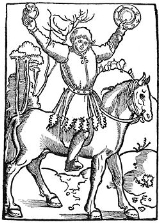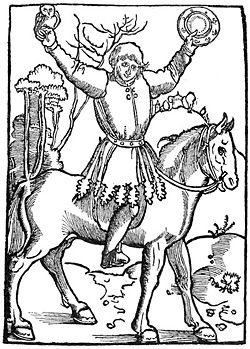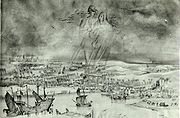
The Legend of Thyl Ulenspiegel and Lamme Goedzak
Encyclopedia


1867 in literature
The year 1867 in literature involved some significant new books.-Events:* Three new American periodicals for children — Oliver Optic's Magazine, Frank Leslie's Boys' and Girls' Weekly, and the Riverside Magazine for Young People — all begin publishing.-New books:*Mary Elizabeth Braddon...
novel
Novel
A novel is a book of long narrative in literary prose. The genre has historical roots both in the fields of the medieval and early modern romance and in the tradition of the novella. The latter supplied the present generic term in the late 18th century....
by Charles De Coster
Charles De Coster
Charles-Theodore-Henri De Coster was a Belgian novelist whose efforts laid the basis for a native Belgian literature....
. Based on the 14th century Low German figure Till Eulenspiegel
Till Eulenspiegel
Till Eulenspiegel was an impudent trickster figure originating in Middle Low German folklore. His tales were disseminated in popular printed editions narrating a string of lightly connected episodes that outlined his picaresque career, primarily in Germany, the Low Countries and France...
, Coster's novel recounts the allegorical adventures as those of a Flemish
Flemish people
The Flemings or Flemish are the Dutch-speaking inhabitants of Belgium, where they are mostly found in the northern region of Flanders. They are one of two principal cultural-linguistic groups in Belgium, the other being the French-speaking Walloons...
prankster Thyl Ulenspiegel during the Reformation
Protestant Reformation
The Protestant Reformation was a 16th-century split within Western Christianity initiated by Martin Luther, John Calvin and other early Protestants. The efforts of the self-described "reformers", who objected to the doctrines, rituals and ecclesiastical structure of the Roman Catholic Church, led...
wars in the Netherlands.
De Coster was one of many 19th Century nationalist writers who made use of - and considerably adapted and changed - pre-existing folk tales. In this case, Thyl Ulenspiegel is made into a Protestant hero of the time of the Dutch War of Independence (or rather, of the major part played in that war by the Flemish
Flemish people
The Flemings or Flemish are the Dutch-speaking inhabitants of Belgium, where they are mostly found in the northern region of Flanders. They are one of two principal cultural-linguistic groups in Belgium, the other being the French-speaking Walloons...
, even though Flanders itself was doomed to remain under Spanish rule).
De Coster incorporated in his book many of the original amusing Ulenspiegel tales, side by side with far from funny material - for example, graphic depictions of tortures by the inquisition
Inquisition
The Inquisition, Inquisitio Haereticae Pravitatis , was the "fight against heretics" by several institutions within the justice-system of the Roman Catholic Church. It started in the 12th century, with the introduction of torture in the persecution of heresy...
and auto de fe. As depicted by De Coster, Ulenspiegel carries in a locket around his neck the ashes of his father, burned at the stake on charges of heresy
Heresy
Heresy is a controversial or novel change to a system of beliefs, especially a religion, that conflicts with established dogma. It is distinct from apostasy, which is the formal denunciation of one's religion, principles or cause, and blasphemy, which is irreverence toward religion...
- a feature never hinted at in any of the original folk tales.
The novel was later illustrated with a series of linocut
Linocut
Linocut is a printmaking technique, a variant of woodcut in which a sheet of linoleum is used for the relief surface. A design is cut into the linoleum surface with a sharp knife, V-shaped chisel or gouge, with the raised areas representing a reversal of the parts to show printed...
s by Frans Masereel
Frans Masereel
Frans Masereel was a Flemish painter and graphic artist who worked mainly in France. He is known especially for his woodcuts. His greatest work is generally said to be the wordless graphic novel Mon Livre d'Heures . He completed over 20 other wordless novels in his career...
, the foremost Belgian modernist painter and engraver.
The movie based on the novel was filmed in the USSR by Aleksandr Alov
Aleksandr Alov
Aleksandr Alov was a Soviet film director and screenwriter, he was granted the honorary title of People's Artist of the USSR in 1983 ....
and Vladimir Naumov, "The Legend of Till Ullenspiegel" (1976).
Ulenspiegel was mentioned in Mikhail Bulgakov
Mikhail Bulgakov
Mikhaíl Afanásyevich Bulgákov was a Soviet Russian writer and playwright active in the first half of the 20th century. He is best known for his novel The Master and Margarita, which The Times of London has called one of the masterpieces of the 20th century.-Biography:Mikhail Bulgakov was born on...
's "The Master and Margarita
The Master and Margarita
The Master and Margarita is a novel by Mikhail Bulgakov, woven around the premise of a visit by the Devil to the fervently atheistic Soviet Union. Many critics consider the book to be one of the greatest novels of the 20th century, and one of the foremost Soviet satires, directed against a...
" as a possible prototype for the black cat
Black cat
A black cat is a feline with black fur. It is not a particular breed of cat and may be mixed or of a specific breed. The Bombay, known for its sleek black fur, is an example of a black cat. The all-black pigmentation is equally prevalent in both male and female cats...
character Behemoth.
The Soviet composer
Composer
A composer is a person who creates music, either by musical notation or oral tradition, for interpretation and performance, or through direct manipulation of sonic material through electronic media...
Nikolai Karetnikov
Nikolai Karetnikov
Nikolai Nikolayevich Karetnikov , was a Russian composer of the so-called Underground – alternative or nonconformist group in Soviet music.-Biography:...
and his librettist Pavel Lounguine adapted De Coster's novel as the samizdat
Samizdat
Samizdat was a key form of dissident activity across the Soviet bloc in which individuals reproduced censored publications by hand and passed the documents from reader to reader...
opera "Till Eulenspiegel" (1983), which had to be recorded in secret and received its premiere (1993) only after the Soviet Union collapsed.

